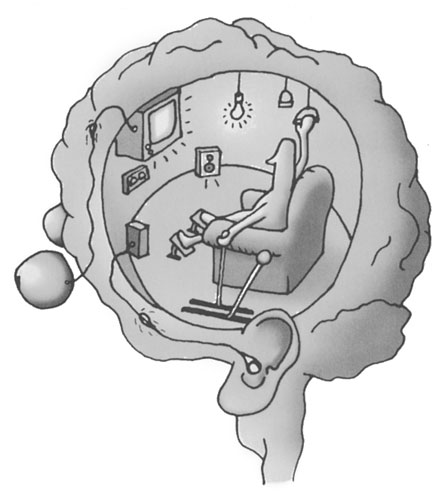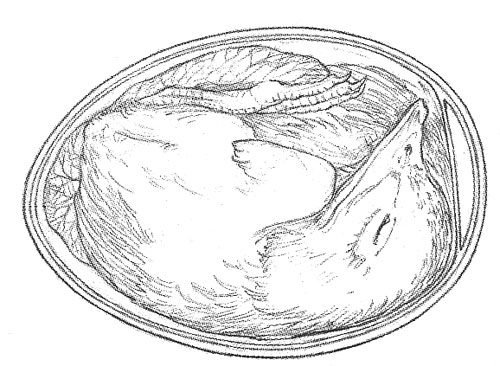Out of Gas, Compass, Consciousness and more...
By David Schneider, Christopher Brodie, Amos Esty
Short takes on seven books
Short takes on seven books

DOI: 10.1511/2004.49.0
A book that tackles both the looming shortage of fossil fuels and the threat of global warming might be expected to weigh several pounds and cause a great deal of eyestrain. Not so David Goodstein's Out of Gas (Norton, $21.95), which spans this territory in a mere 140 pages of easy reading.
Of course, a book of this size cannot delve that deeply when the discussion comes around to complicated issues—say, those surrounding nuclear energy or carbon sequestration. But Goodstein does a fine job of summarizing these topics (and many others) briefly and clearly for those not familiar with them. His descriptions are very basic (the book includes, for example, a broad introduction to thermodynamics), and the explanations are deliberately kept simple, as you might expect from a physics professor.
What is more, Goodstein's comments about energy and climate are refreshingly difficult to characterize: One can't predict from which side of the aisle his next statement will emerge. For example, he notes that improved solar cells might "make the Saudi Arabian desert more valuable for the sunlight falling on it than for the oil buried beneath it." Score one for the environmental movement. Yet in the same chapter he notes that the failure of the Bush administration to ratify the Kyoto Protocol "may be just as well," since "it's too weak to do much good for the atmosphere," echoing Bjørn Lomborg's The Skeptical Environmentalist.
If you want to examine such assertions in detail, this is not the book to guide you through that scientific, economic and political jungle. But if you want to get a look at the whole forest at once, Goodstein's little book will float you appropriately high above the trees.—D.A.S.

From Compass: A Story of Exploration and Innovation
In Compass: A Story of Exploration and Innovation (Norton, $22.95), yacht designer and photographer Alan Gurney tells the strange story of a world–transforming technology that required 700 years to perfect.
From its first appearance in 12th–century China, the marine magnetic compass proved a stubbornly fickle guide. The fragile needle could be confused by pounding waves, weakened by gunfire or betrayed by a ship's own iron. These were hugely important problems: As late as the 1850s a British ship was lost practically every day—"the nineteenth–century equivalent," Gurney writes, "of jumbo jets falling out of the skies."
Finding solutions to these puzzles fell to a colorful line of scientists, engineers and sailors, described by Gurney with a novelist's eye for detail. The brilliant Edmond Halley made two historic voyages to chart magnetic variation; the enterprising Gowin Knight hoarded the secret of his artificial magnet machine; and the almost comically unlucky Matthew Flinders endured disease, shipwreck, marooning and imprisonment to bring his treasured book of bearings to the British Admiralty.
Perfecting the instrument ultimately changed trading patterns, improved the accuracy of maps and charts and gave comfort to countless sailors on the midnight watch—a testament to the value of patient refinement.—G.R.

From Consciousness: An Introduction
How is it that mere matter can experience a sad thought, the color blue or the taste of a cheese–and–pepperoni pizza? Questions of this sort are central to the scientific explanation of consciousness, which author Susan Blackmore explores in Consciousness: An Introduction (Oxford University Press, $39.95, paper). Ostensibly written as a college text, Blackmore's book turns out to be a page–turner. It repeatedly evokes unsettling moments of reflection as the reader is introduced to ideas that bump up against the ceiling of human understanding. Indeed, as Blackmore explains, "mysterians" such as the British philosopher Colin McGinn argue that human beings are "cognitively closed" to the problem: We don't have the right kind of brain to solve it, just as a dog cannot comprehend a poem. Others, including the American philosopher Daniel Dennett, believe that we've misconstrued consciousness itself and that we must really explain how it comes to seem that there is actual phenomenology. According to Dennett, there is no "Cartesian theater"—the place where "I" am inside "my" mind or brain (see cartoon above). Whatever your preconceived notions of "self," Blackmore's book will surely get you thinking—wherever and whatever "you" may be.—M.S.

From The Birdwatcher's Companion to North American Birdlife
A newly revised edition of The Birdwatcher's Companion to North American Birdlife (Princeton University Press, $39.50), by ornithologist Christopher W. Leahy, provides a thousand–page A–to–Z guide to all things avian. Leahy clearly loves birds, and this affectionate yet scholarly work offers everything from terse definitions and simple descriptions to thoughtful and authoritative essays that can occupy several pages. Among the expected entries—such as birdwatching, conservation, endangered species and migration—we also find three pages about edibility, where the reader will learn of a 19th–century Boston restaurant that served up a thousand hummingbirds "in Walnut Shells" every night! Further treasures can be found under nouns of assemblage, which provides alternatives to the prosaic "flock of birds," including poetic couplings such as an "ostentation of peacocks," a "murder of crows" and a "pitying of doves."
In addition to the alphabetic entries, there are also six appendices, including a checklist of North American birds, a classification of extinct birds and a birdwatcher's calendar. An extremely useful bibliography that lists sources according to subject caps off the volume. There is much here that will engage every level of birder. Above: A chick in its egg, from the entry under embryo.—M.S.

From Carpet Monsters and Killer Spores
Nicholas P. Money broke the mold of traditional mycology guides with his critically acclaimed essay collection Mr. Bloomfield's Orchard. In his latest book, Carpet Monsters and Killer Spores (Oxford, $24.95), the British–born botanist brings some much–needed common sense to homeowners' concerns about fungal threats to property and peace of mind.
Health risks associated with household mold are yet to be determined, but recent side effects are unmistakable: media frenzies, multimillion–dollar lawsuits, headaches for insurance companies and high–priced offers to assess and remove the offending spores with unproven techniques.
Money's empathy, objectivity and quick wit make this book a welcome contribution to a contentious debate in which some of the scientific evidence is sketchy. But "a deep knowledge of fungi is unnecessary," Money says, "when a bucket of bleach and a scrubbing brush may be the most important tools of the trade."
Shown above is the fruiting body of Serpula lacrymans, a fungus that causes dry rot in the wood of European, Japanese and Australian homes.—F.D.
Between Antarctica and Cape Horn lie 600 miles of the world's stormiest seas. The southernmost point of South America, the small island of Cape Horn and surrounding waters have long represented the ultimate challenge to seamanship. Enormous waves, sudden squalls and treacherous shores have claimed the lives of hundreds of those intrepid, foolish or desperate enough to venture into the Southern Ocean. In Rounding the Horn: Being the Story of Williwaws and Windjammers, Drake, Darwin, Murdered Missionaries and Naked Natives—A Deck's Eye View of Cape Horn (Basic Books, $25.95), Dallas Murphy recounts the Cape's gruesome history and explains the science behind its fierce weather, while also telling the story of his own trip around the Horn. Along the way, we meet explorers such as Francis Drake (who discovered the passage in 1578), scientists such as Charles Darwin, and victims of European wanderlust such as the Yahgan, a primitive, nomadic people who survived the rough climes of Cape Horn for centuries only to be quickly decimated by Old World diseases in the 19th century. Rounding the Horn illustrates the often close ties between science and adventure, and makes for a read both exciting and edifying.—A.E.
The suburbs, as you've probably heard by now, are a mixed blessing. Yes, the houses are cheaper, and each is likely to have its own patch of turf out back. Yes, suburbanites often enjoy less noise than city residents and more access to shopping than rural folk. But there are costs. By their nature, suburbs are inefficient—they waste land, require expensive infrastructure, geographically separate houses from workplaces and stores, and foster a sense of isolation from the neighbors. Worst of all, they force residents to climb into their cars for even the simplest daily errands.
Dan Chiras and Dave Wann suggest answers to these problems in Superbia! (New Society Publishers, $19.95). This guide, subtitled 31 Ways to Create Sustainable Neighborhoods, advocates a grassroots path to a retrofitted, new–urbanist ideal of compact, mixed–use developments. Chiras and Wann give a list of steps for adapting suburban neighborhoods, warts and all, into closer, less wasteful and more environmentally friendly communities. The proposals include one–time staples of small–town life, such as holding potluck dinners, as well as more audacious suggestions—buying a van or truck for shared use, setting up a community–shared office, or creating a community energy system that uses solar panels or wind turbines. If you've ever looked over your suburban fence into a neighborhood of quarter–acre fiefdoms and longed for something different, this book may be for you.—C.B.
Click "American Scientist" to access home page
American Scientist Comments and Discussion
To discuss our articles or comment on them, please share them and tag American Scientist on social media platforms. Here are links to our profiles on Twitter, Facebook, and LinkedIn.
If we re-share your post, we will moderate comments/discussion following our comments policy.